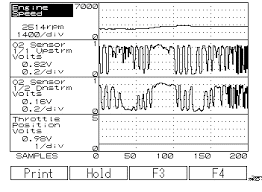Repair Information for P0420 Honda code. Learn what does P0420 Honda Catalyst System Efficiency Below Threshold Bank 1 means and how to diagnose p0420 code
Diagnosing a P0420
Tests/Procedures: 1. Verify that the fuel trims on both banks are good at idle and when driving the vehicle. It is possible to have the fuel trim at 20% and not set a fuel trim code and cause the catalytic converter to not function properly.
2. If the fuel trim is only off on one bank, look for a faulty Air/Fuel (A/F) Ratio sensor, a vacuum leak or a fuel delivery problem on the bank the fuel trim is off on.
3. If the fuel trim is good and within 10% plus or minus, drive the vehicle at a steady throttle, steady cruise and monitor the rear O2 sensor operation. If the rear O2 sensor is switching rich to lean, the catalytic converter is not storing oxygen correctly. When the catalytic converter functions correctly, the rear O2 sensor should not switch. If the rear O2 sensor switches at a steady cruise while driving, the catalytic converters are failing.
4. Since this vehicle uses Air/Fuel (A/F) Ratio sensors instead of front O2 sensors, if the vehicle has high mileage, it is always wise to replace the front A/F Ratio sensors if the catalytic converters are faulty and need to be replaced. In some cases, the A/F Ratio sensors can cause a false code P0420.
On the vehicle in the video, The only reason the cat was replaced on this car was due to rust and it set the p0420 the day after. And here is the follow-up video to the first on. A complete guide to diagnosing a p0420 on a Honda CRV
Below are some very useful comments left on my subreddit post. That could definitely be useful in diagnosing a p0420 code.
O2 sensor and Air Fuel sensors Look the same but work Differently.
Using Fuel Trim Data to Diagnose a P0420 code (Rich or Lean Condition)


Leaking Exhaust or Bad Catietic Converter?
After Market Catiletic Converters VS OEM
Response:

Deprecated: str_contains(): Passing null to parameter #1 ($haystack) of type string is deprecated in /home1/specrac1/public_html/wp-includes/comment-template.php on line 2656